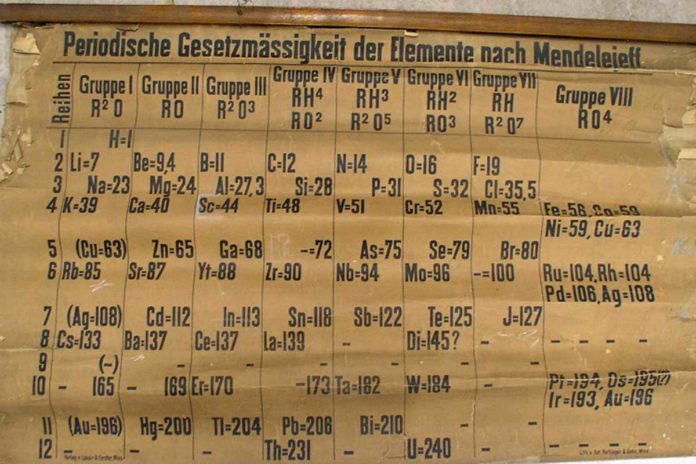Scientists have discovered the world’s oldest periodic table that involves elements, dating from 1885. The chart of elements was discovered in the University’s School of Chemistry in 2014 by Dr. Alan Aitken during a clear out.
The storage area was brimming with chemical substances, equipment and lab stuff that had amassed since the opening of the science division at its present area in 1968. Following a very long time of clearing and arranging the different materials a stash of rolls up teaching charts was found.
Inside the collection was a large, amazingly delicate periodic table that chipped after taking care of. Proposals that the revelation might be the most punctual enduring case of a classroom periodic table in the world implied the archive required pressing consideration regarding be confirmed, fixed and reestablished.
Mendeleev made his well-known divulgence on periodicity in 1869, the recently uncovered table was somewhat comparable, yet not indistinguishable to Mendeleev’s second table of 1871. Be that as it may, the St Andrews table was obviously an early example. The table is commented on in German, and an engraving at the base left – ‘Verlag v. Lenoir and Forster, Wien’ – distinguishes a logical printer who worked in Vienna somewhere in the range of 1875 and 1888. Another engraving – ‘Lith. von Ant. Hartinger and Sohn, Wien’ – recognizes the diagram’s lithographer, who kicked the bucket in 1890.
Scientists found that the way the periodic table is organized isn’t arbitrary. In fact, it is a reflection of objective reality. By finding where an element fits in the table, a chemist can, without even having a sample of the element, tell if it is a metal, a noble gas, an alkali metal, as well as a great deal about how it will interact with other elements. In addition, it was possible to deduce the properties of elements that hadn’t been discovered yet due to the gaps they filled in the table.
It’s this last fact that helped scholars to date the St Andrews periodic table. According to the university, the table is similar to the second version that Mendeleev drew up in 1869, but there are discrepancies.
Gallium and scandium, discovered in 1875 and 1879, respectively, are included in the table, but germanium, which was discovered in 1886, is not. This corresponds to an inscription on the table, which reads, “Verlag v. Lenoir & Forster, Wien.” referring to a Viennese scientific printer that was in business from 1877 to 1888. The purchase was made by a professor of Chemistry Thomas Purdie, who had a strong interest in the rising field of organic chemistry.
When it was found, the St Andrews periodic table was in a shocking state after many decades of neglect. The paper was fragile and brittle due to oxidation and acidic wear on the fibers – not to mention it’s being rolled up and bearing the weight of a heavy linen backing.
Under a grant from the National Manuscripts Conservation Trust (NMCT), special collections in collaboration with Richard Hawkes from Artworks Conservation undertook a grueling conservation effort. According to the university, this involved brushing away loose debris, taking off the linen backing, washing the chart in neutral-pH deionized water, deacidification using a bath of hydrogen carbonate, repairing it with Japanese Kozo paper and wheat starch paste, and rehousing it properly under controlled conditions.
Professor David O’Hagan, recent ex-Head of Chemistry at the University of St Andrews said, “The discovery of the world’s oldest classroom periodic table at the University of St Andrews is remarkable. The table will be available for research and display at the University and we have a number of events planned in 2019, which has been designated international year of the periodic table by the United Nations, to coincide with the 150th anniversary of the table’s creation by Dmitri Mendeleev.”
